A Multi-Hazard Risk Assessment Model for a Road Network Based on Neural Networks and Fuzzy Comprehensive Evaluation
Abstract
1. Introduction
2. Methodology
2.1. Road Network Risk Assessment Model
2.2. Fuzzy Comprehensive Evaluation
2.3. Neural Networks
2.4. Conditioning Factors
3. Model Training
3.1. Data
3.2. Training
4. Case Study
4.1. Risk Prediction
4.2. Validation
5. Conclusions
- The FCE can effectively handle ambiguous and uncertain information, while neural networks have strong information-processing capabilities and autonomous learning abilities. This paper utilizes both to construct a road natural disaster risk assessment model, enabling the full play of their respective strengths and achieving good predictions for the natural disaster risk in road networks.
- Based on the statistical analysis of natural disasters in road networks, ten influencing factors were selected from meteorological, geological, and human activity aspects as input parameters for the road natural disaster risk model. Through case studies, it has been demonstrated that the selected influencing factors adequately express and reflect the model’s characteristics, meeting the requirements for road natural disaster risk assessment.
- Taking Guangxi as an example, this paper completed the training of a road natural disaster risk assessment model. The training results were satisfactory, and the model was used to predict the natural disaster risk in Lingchuan County, Guangxi. The results indicated a high precision in the predictions, providing technical support for road disaster prevention.
6. Recommendations
Author Contributions
Funding
Institutional Review Board Statement
Informed Consent Statement
Data Availability Statement
Conflicts of Interest
References
- Zhu, Z.J.; Zhang, Y. Flood disaster risk assessment based on random forest algorithm. Neural Comput. Appl. 2021, 34, 3443–3455. [Google Scholar] [CrossRef]
- Gill, J.C.; Malamud, B.D. Hazard interactions and interaction networks (cascades) within multi-hazard methodologies. Earth Syst. Dyn. 2016, 7, 659–679. [Google Scholar] [CrossRef]
- Kappes, M.S.; Keiler, M.; von Elverfeldt, K.; Glade, T. Challenges of analyzing multi-hazard risk: A review. Nat. Hazards 2012, 64, 1925–1958. [Google Scholar] [CrossRef]
- Sekhri, S.; Kumar, P.; Fürst, C.; Pandey, R. Mountain specific multi-hazard risk management framework (MSMRMF): Assessment and mitigation of multi-hazard and climate change risk in the Indian Himalayan Region. Ecol. Indic. 2020, 118, 106700. [Google Scholar] [CrossRef]
- Dilley, M.; Mundial, B. Natural Disaster Hotspots: A Global Risk Analysis; World Bank, Hazard Management Unit: Washington, DC, USA, 2005. [Google Scholar]
- Carreño, M.L.; Cardona, O.; Barbat, A.H.; Suarez, D.C.; Perez, M.D.P.; Narvaez, L. Holistic Disaster Risk Evaluation for the Urban Risk Management Plan of Manizales, Colombia. Int. J. Disaster Risk Sci. 2017, 8, 258–269. [Google Scholar] [CrossRef][Green Version]
- Shome, P.; Afroj, S. Local Level multi-hazards mapping for natural and manmade hazards: A case study of Chittagong Division. J. Environ. Eng. Its Scope 2019, 2, 1–9. [Google Scholar]
- Araya-Munoz, D.; Metzger, M.J.; Stuart, N.; Wilson, A.M.W.; Carvajal, D. A spatial fuzzy logic approach to urban multi-hazard impact assessment in conception, Chile. Sci. Total Environ. 2017, 576, 508–519. [Google Scholar] [CrossRef] [PubMed]
- Nadim, F.; Kjekstad, O. Assessment of Global High-Risk Landslide Disaster Hotspots. In Landslides—Disaster Risk Reduction; Springer: Berlin/Heidelberg, Germany, 2009; pp. 213–221. [Google Scholar]
- Peduzzi, P.; Dao, H.; Herold, C.; Mouton, F. Assessing global exposure and vulnerability towards natural hazards: The Disaster Risk Index. Nat. Hazards Earth Syst. Sci. 2009, 9, 1149–1159. [Google Scholar] [CrossRef]
- Xu, W.; Ming, X.D.; Ma, Y.J.; Zhang, X.H.; Shi, P.J.; Zhuo, L.; Lu, B.Q. Quantitative Multi-Hazard Risk Assessment of Crop Loss in the Yangtze River Delta Region of China. Sustainability 2019, 11, 922. [Google Scholar] [CrossRef]
- Liu, H.; Chen, H.; Hong, R.; Liu, H.; You, W. Mapping knowledge structure and research trends of emergency evacuation studies. Saf. Sci. 2020, 121, 348–361. [Google Scholar] [CrossRef]
- Choe, T.; Kim, J.; Shin, M.; Kim, K.; Kim, M. Complex disaster response framework to reduce urban disaster vulnerability. Sci. Prog. 2023, 106, 1. [Google Scholar] [CrossRef]
- Dong, S.J.; Esmalian, A.; Farahmand, H.; Zachry, A.M. An integrated physical-social analysis of disrupted access to critical facilities and community service-loss tolerance in urban flooding. Comput. Environ. Urban Syst. 2022, 93. [Google Scholar] [CrossRef]
- Lin, C.Y.; Lai, Y.C.; Wu, S.W.; Mo, F.C.; Lin, C.Y. Assessment of potential sediment disasters and resilience management of mountain roads using environmental indicators. Nat. Hazards 2022, 111, 1951–1975. [Google Scholar] [CrossRef]
- Pellicani, R.; Argentiero, I.; Spilotro, G. GIS-based predictive models for regional-scale landslide susceptibility assessment and risk mapping along road corridors. Geomat. Nat. Hazards Risk 2018, 8, 1012–1033. [Google Scholar] [CrossRef]
- Huang, G.W. Enhancing Dialogue between Flood Risk Management and Road Engineering Sectors for Flood Risk Reduction. Sustainability 2018, 10, 1773. [Google Scholar] [CrossRef]
- Wang, J.H.; Qin, Q.M.; Zhao, J.H.; Ye, X.; Feng, X.; Qin, X.B.; Yang, X.C. Knowledge-Based Detection and Assessment of Damaged Roads Using Post-Disaster High-Resolution Remote Sensing Image. Remote Sens. 2015, 7, 4948–4967. [Google Scholar] [CrossRef]
- Zhao, K.; Liu, J.J.; Wang, Q.N.; Wu, X.J.; Tu, J.H. Road Damage Detection from Post-Disaster High-Resolution Remote Sensing Images Based on TLD Framework. IEEE Access 2022, 10, 43552–43561. [Google Scholar] [CrossRef]
- Tadano, K.; Maeno, Y.; Carnevali, L. Road Repair Sequencing for Disaster Victim Evacuation. Adv. Soc. Simul. 2015 2017, 528, 401–412. [Google Scholar]
- Kim, J.; Park, J.; Kim, K.; Kim, M. RnR-SMART: Resilient smart city evacuation plan based on road network reconfiguration in outbreak response. Sustain. Cities Soc. 2021, 75, 103386. [Google Scholar] [CrossRef]
- Malakar, S.; Rai, A.K.; Gupta, A.K. Earthquake risk mapping in the Himalayas by integrated analytical hierarchy process, entropy with neural network. Nat. Hazards 2023, 116, 951–975. [Google Scholar] [CrossRef]
- Meng, X.J.; Chang, J.X.; Wang, X.B.; Wang, Y.; Wang, Z. Flood control operation coupled with risk assessment for cascade reservoirs. J. Hydrol. 2019, 572, 543–555. [Google Scholar] [CrossRef]
- Chen, H.; Xu, Z.X.; Liu, Y.; Huang, Y.X.; Yang, F. Urban Flood Risk Assessment Based on Dynamic Population Distribution and Fuzzy Comprehensive Evaluation. Int. J. Environ. Res. Public Health 2022, 19, 16406. [Google Scholar] [CrossRef]
- Jiang, J.C.; Wang, F.; Wang, Y.Z.; Jiang, W.Y.; Qiao, Y.M.; Bai, W.F.; Zheng, X.X. An Urban Road Risk Assessment Framework Based on Convolutional Neural Networks. Int. J. Disaster Risk Sci. 2023, 14, 475–487. [Google Scholar] [CrossRef]
- JTJ 003-86[S/OL]; Standard of Climatic Zoning for Highway. Standards Press of China: Beijing, China, 1986.
- Santini, M.; Grimaldi, S.; Nardi, F.; Petroselli, A.; Rulli, M.C. Pre-processing algorithms and landslide modelling on remotely sensed DEMs. Geomorphology 2009, 113, 110–125. [Google Scholar] [CrossRef]
- Liu, X.; Zhou, P.; Lin, Y.C.; Sun, S.W.; Zhang, H.L.; Xu, W.Q.; Yang, S.D. Influencing Factors and Risk Assessment of Precipitation-Induced Flooding in Zhengzhou, China, Based on Random Forest and XG Boost Algorithms. Int. J. Environ. Res. Public Health 2022, 19, 16544. [Google Scholar] [CrossRef]
- Rahimi, D.; Hasheminasab, S.; Abdollahi, K. Assessment of temperature and rainfall changes in the Karoun River basin. Theor. Appl. Climatol. 2019, 137, 2829–2839. [Google Scholar] [CrossRef]
- Bordoni, M.; Persichillol, M.G.; Meisina, C.; Crema, S.; Cavalli, M.; Bartelletti, C.; Galanti, Y.; Barsanti, M.; Giannecchini, R.; Avanzi, G.D. Estimation of the susceptibility of a road network to shallow landslides with the integration of the sediment connectivity. Nat. Hazards Earth Syst. Sci. 2018, 18, 1735–1758. [Google Scholar] [CrossRef]
- Wang, Y.X.; Li, S.Y.; Li, B. Deformation Prediction of Cihaxia Landslide Using InSAR and Deep Learning. Water 2022, 14, 3990. [Google Scholar] [CrossRef]
- Zhang, S.; Li, C.; Peng, J.Y.; Peng, D.L.; Xu, Q.; Zhang, Q.; Bate, B. GIS-based soil planar slide susceptibility mapping using logistic regression and neural networks: A typical red mudstone area in southwest China. Geomat. Nat. Hazards Risk 2021, 12, 852–879. [Google Scholar] [CrossRef]
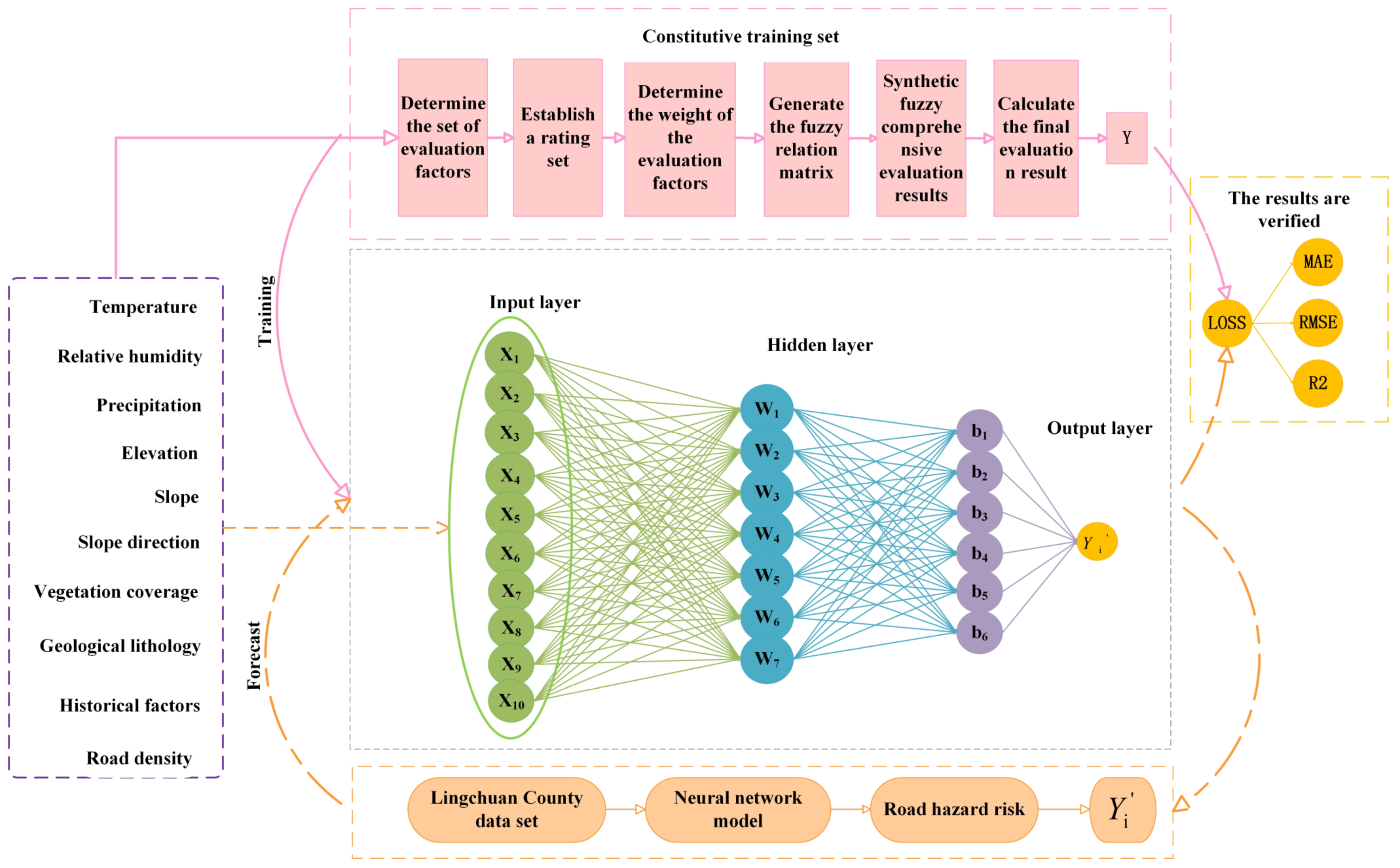
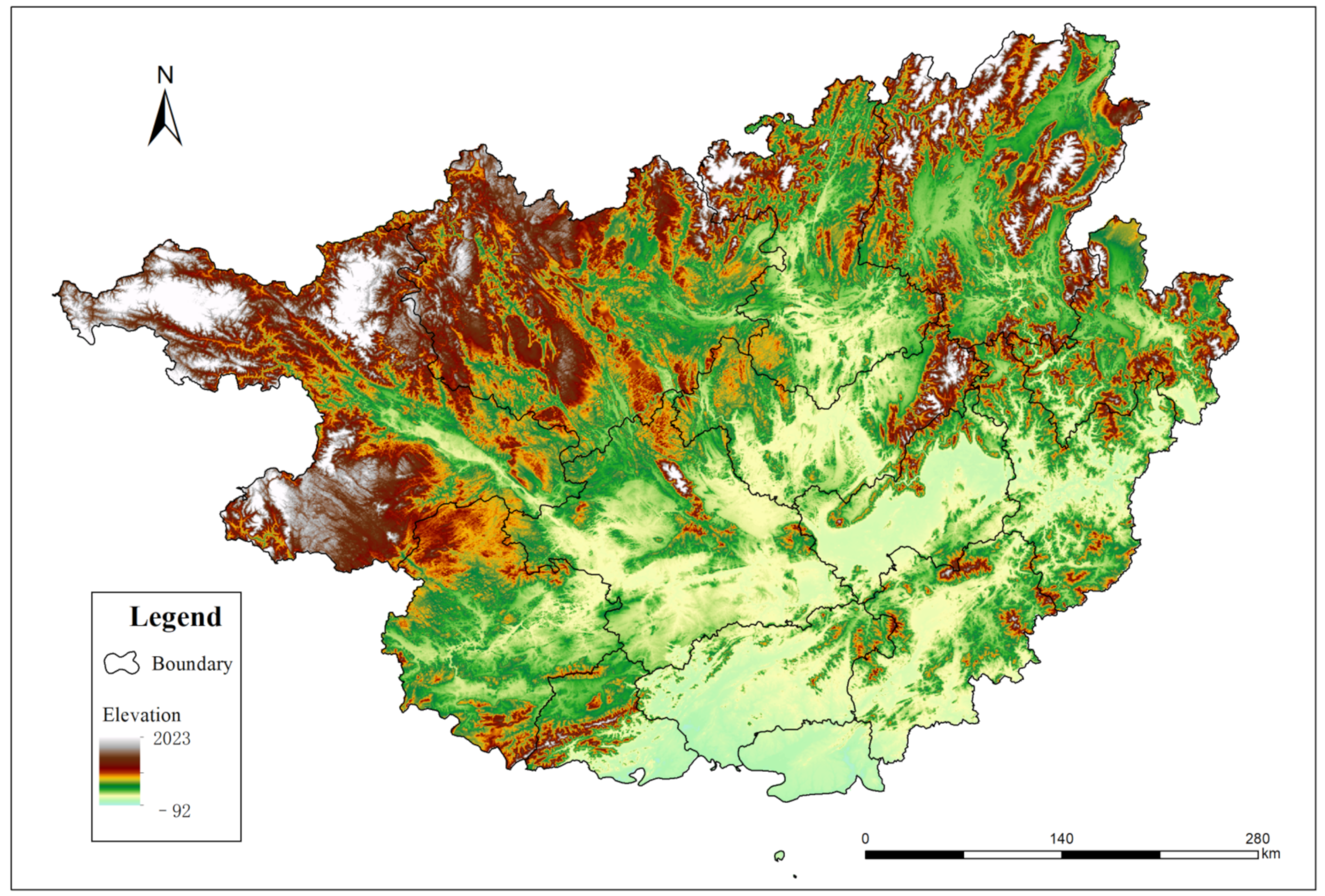

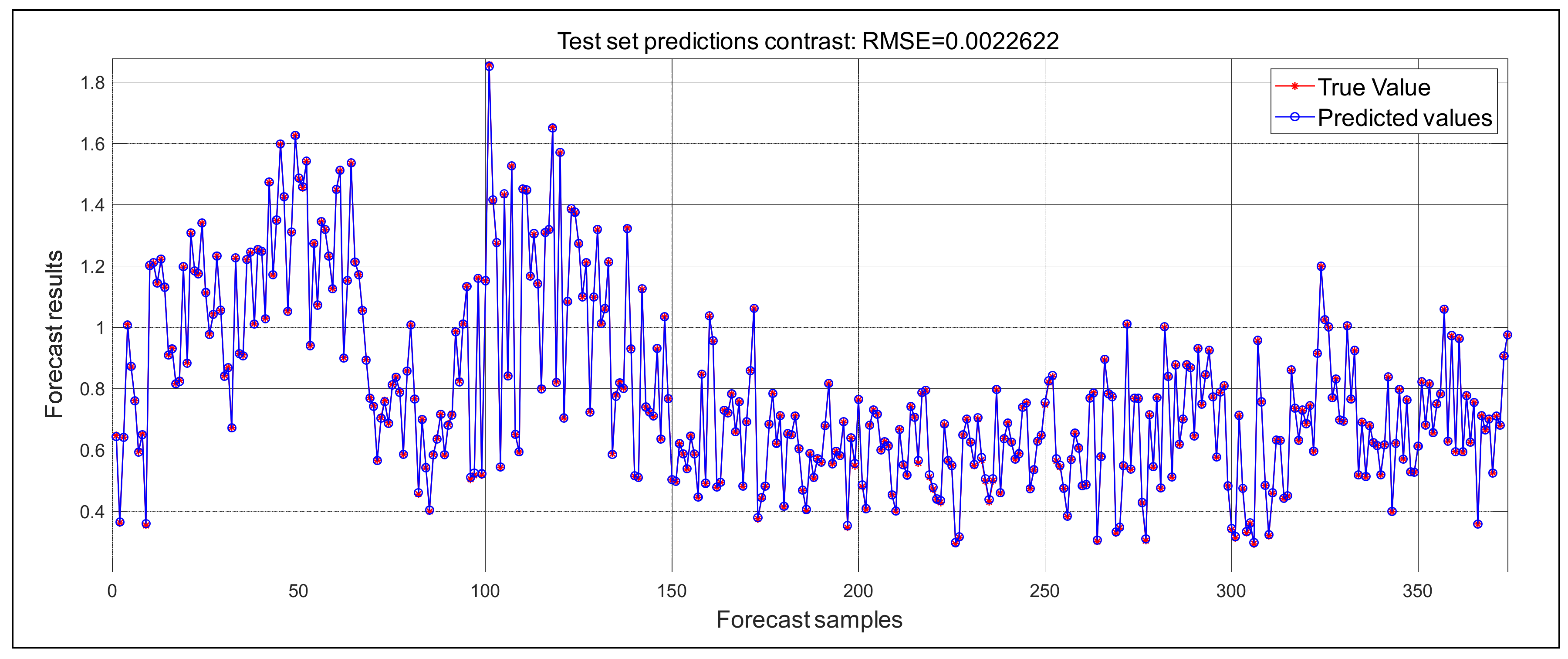
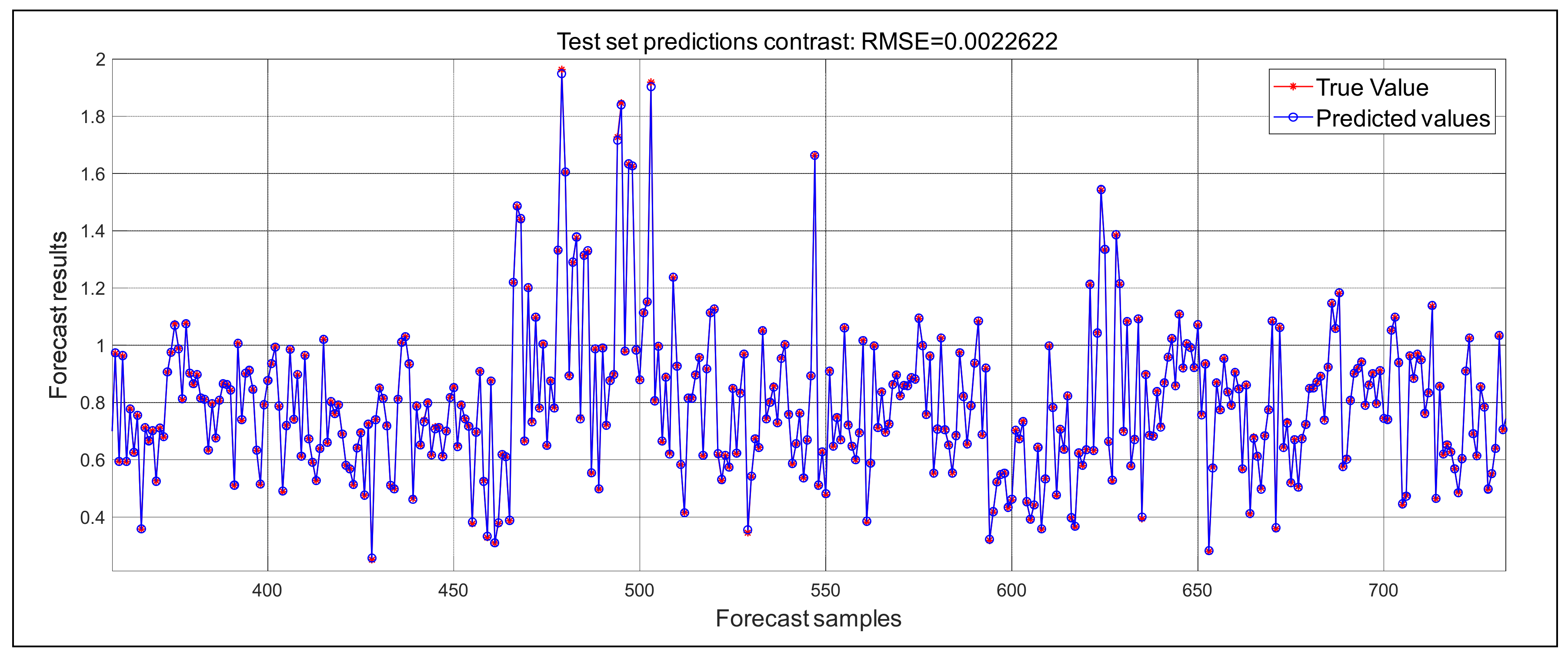
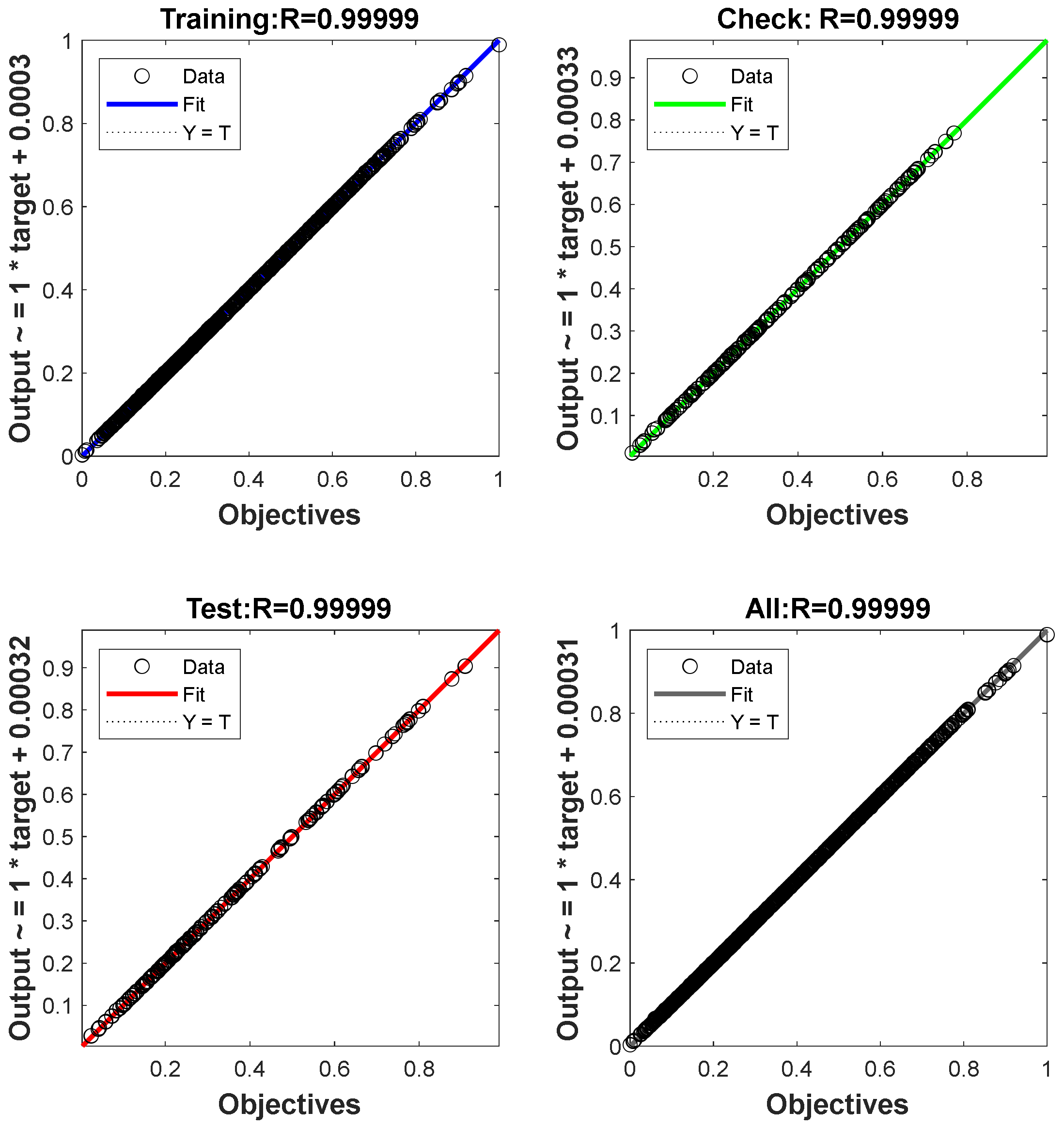
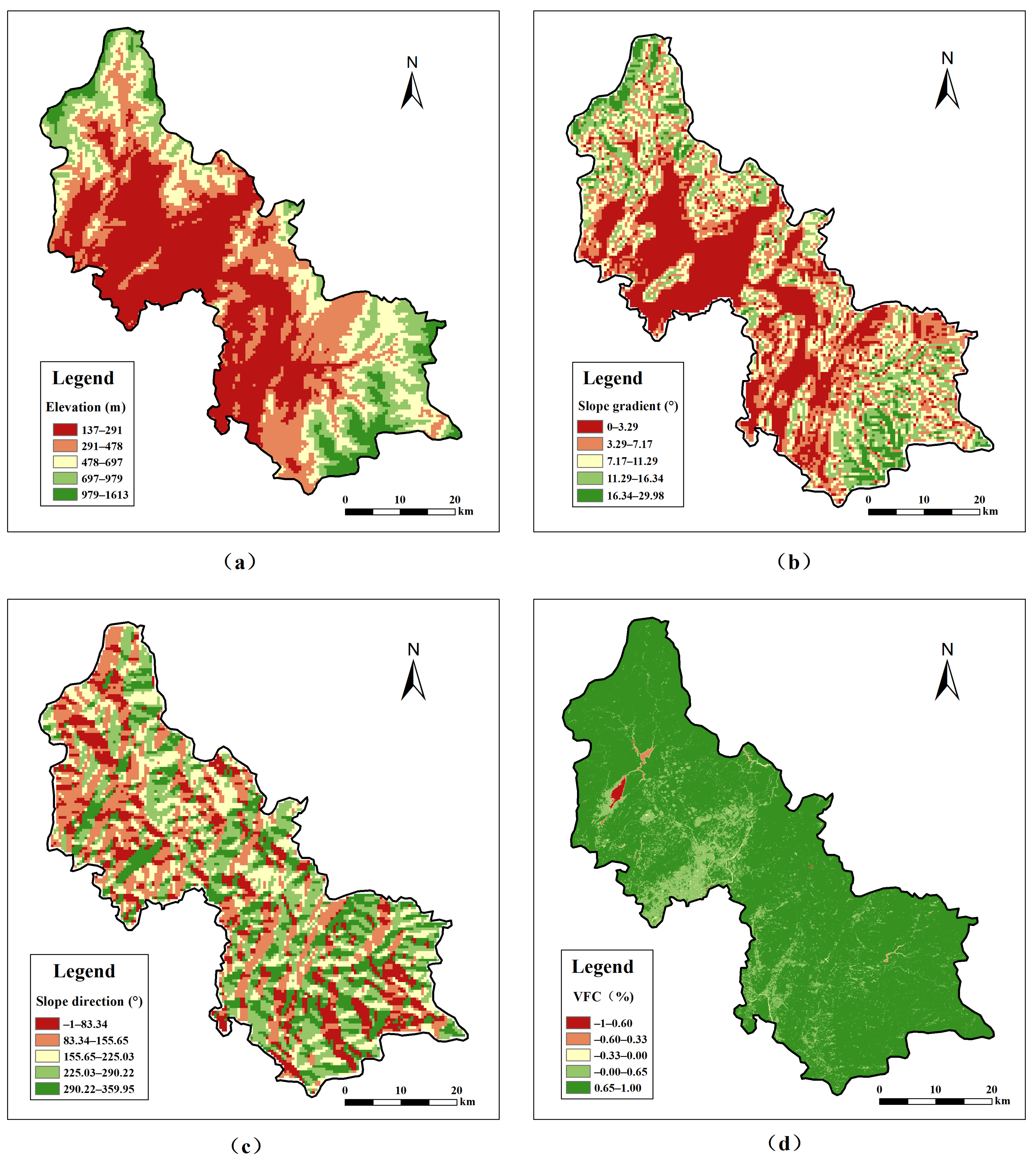
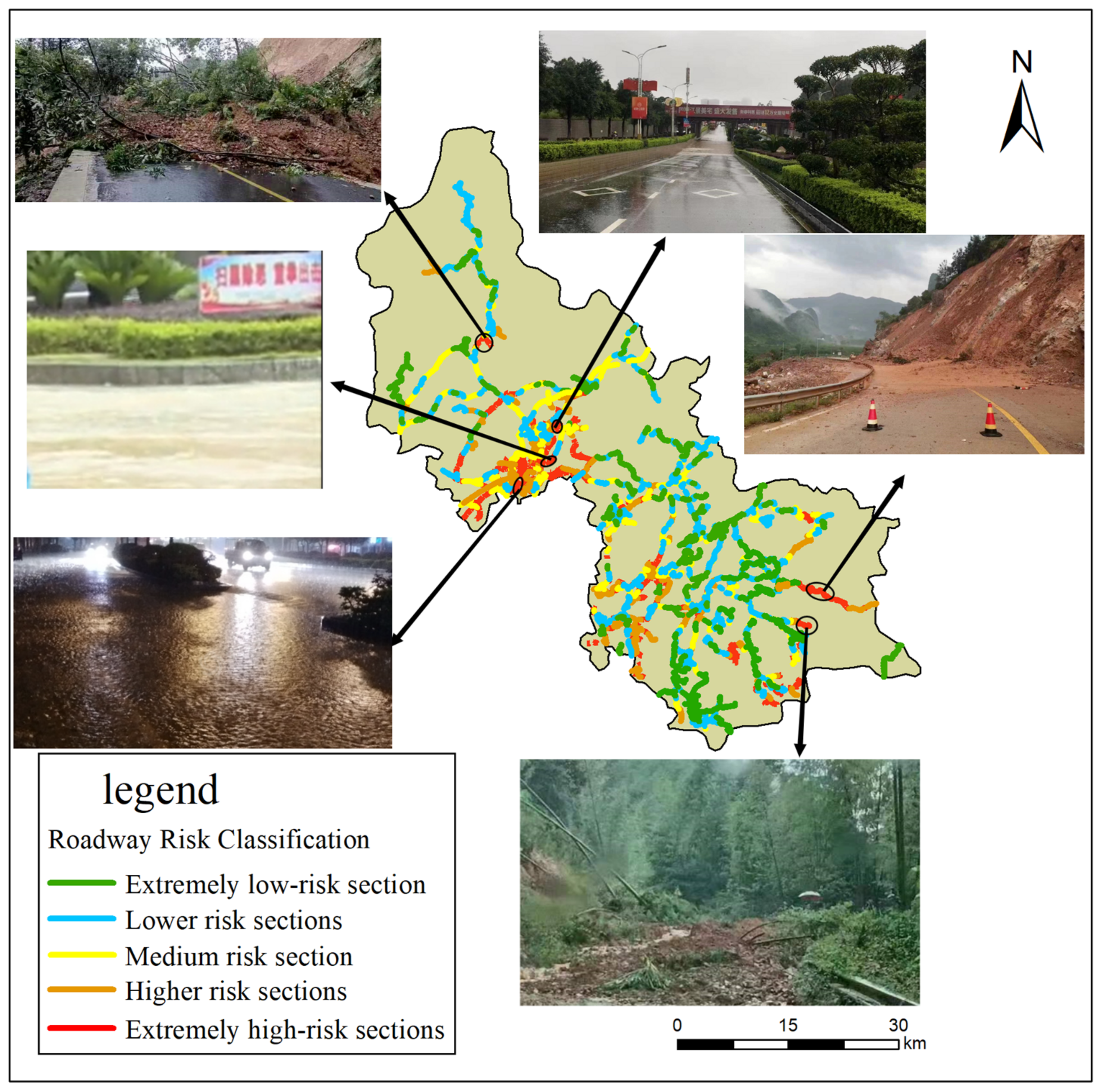
| LOSS | MAE | RMSE | R |
|---|---|---|---|
| Expression |
| Group | Category | Index (Id) |
|---|---|---|
| I | Meteorological conditions | Temperature (x1); relative humidity (x2); precipitation (x3). |
| II | Geological conditions | Elevation (x5); slope gradient(x6); slope orientation (x7); Geologic lithology (x8); vegetation cover (x9). |
| III | Human activity condition | Historical impact factors (x4); road density (x8). |
| Rock Type | Magma | Carbonate | Clastic | Metamorphic | Clay | Sandy | Loess | Gravelly |
|---|---|---|---|---|---|---|---|---|
| Reference Value | 0.1 | 0.2 | 0.3 | 0.4 | 0.5 | 0.6 | 0.7 | 0.8 |
| Data Type | Data Source | Information Obtained | Data Obtained |
|---|---|---|---|
| Weather Data | World Weather’s official website https://worldweather.wmo.int/zh/home.html | Climatic conditions | Temperature, relative humidity, and precipitation |
| DEM Data | Geospatial Data Cloud 30 M Resolution Data https://www.gscloud.cn/ | Digital Elevation Model | Elevation, slope, and slope orientation |
| Vegetation Coverage | ESA Glob Cover https://earthexplorer.usgs.gov/ | Satellite remote sensing data | Fractional vegetation cover () |
| Road Vector Data | OSM (Open Street Map) official website of the latest data https://openmaptiles.org/languages/zh/#0.55/0/0 | Road vector data | Road density |
| Geological lithology | National Geological Archive https://www.ngac.cn/125cms/c/qggnew/index.htm | Geological information | Geologic lithology and Historical impact factors |
| Id | x1 (Temperature, °C) | x2 (Relative Humidity, %) | x3 (Precipitation, mm) | x4 (Historical Impact Factors) | x5 (Elevation, m) | x6 (Slope Gradient, °) | x7 (Slope Orientation, °) | x8 (Geologic Lithology) | x9 (VFC, %) | x10 (Road Density, km2) | Y (Evaluation Results) |
|---|---|---|---|---|---|---|---|---|---|---|---|
| 1 | 30.2 | 72 | 0 | 0.983 | 242 | 57.20 | 8.74 | 0.3 | 0.79 | 0 | 0.48 |
| ⋮ | ⋮ | ⋮ | ⋮ | ⋮ | ⋮ | ⋮ | ⋮ | ⋮ | ⋮ | ⋮ | ⋮ |
| 20 | 28.5 | 83 | 0 | 0.983 | 95 | 316.49 | 6.72 | 0.3 | 0.85 | 1.00 | 0.62 |
| ⋮ | ⋮ | ⋮ | ⋮ | ⋮ | ⋮ | ⋮ | ⋮ | ⋮ | ⋮ | ⋮ | ⋮ |
| 1873 | 23.1 | 95 | 1 | 0.984 | 401 | 106.01 | 1.85 | 0.2 | 0.74 | 3.16 | 0.73 |
| ⋮ | ⋮ | ⋮ | ⋮ | ⋮ | ⋮ | ⋮ | ⋮ | ⋮ | ⋮ | ⋮ | ⋮ |
| 1933 | 19 | 67 | 0 | 0.984 | 536 | 160.56 | 1.13 | 0.3 | 0.89 | 0 | 0.91 |
| Results | MAE | RMSE | R |
|---|---|---|---|
| Training set | 0.0012403 | 0.0018639 | 0.99998 |
| Prediction set | 0.0015697 | 0.0022824 | 0.99993 |
| Id | x1 (Temperature, °C) | x2 (Relative Humidity, %) | x3 (Precipitation, mm) | x4 (Historical Impact Factors) | x5 (Elevation, m) | x6 (Slope Gradient, °) | x7 (Slope Orientation, °) | x8 (Geologic Lithology) | x9 | x10 (Road Density, km2) | Y (Evaluation Results) |
|---|---|---|---|---|---|---|---|---|---|---|---|
| 1 | 7.5 | 71 | 0 | 0.987 | 369 | 248.54 | 2.54 | 0.6 | 0.82 | 5.11 | 0.42 |
| ⋮ | ⋮ | ⋮ | ⋮ | ⋮ | ⋮ | ⋮ | ⋮ | ⋮ | ⋮ | ⋮ | |
| 789 | 24 | 62 | 0 | 0.987 | 246 | 163.33 | 7.57 | 0.2 | 0.56 | 4.69 | 0.24 |
| ⋮ | ⋮ | ⋮ | ⋮ | ⋮ | ⋮ | ⋮ | ⋮ | ⋮ | ⋮ | ⋮ | |
| 2388 | 18.6 | 45 | 0 | 0.987 | 378 | 249.43 | 5.75 | 0.3 | 0.83 | 12.51 | 0.13 |
| Forecast Result (Y) | Road Risk Classification | Polyline Colors | Predicted Number of Damaged Roads | The Actual Number of Damaged Roads |
|---|---|---|---|---|
| Y < 0.2 | Extremely low-risk section | Green | 20 | 0 |
| 0.2 ≤ Y < 0.4 | Lower-risk section | Blue | 13 | 0 |
| 0.4 ≤ Y < 0.6 | Medium-risk section | Yellow | 7 | 0 |
| 0.6 ≤ Y < 0.8 | Higher-risk section | Orange | 11 | 0 |
| Y > 0.8 | Extremely high-risk section | Red | 8 | 6 |
Disclaimer/Publisher’s Note: The statements, opinions and data contained in all publications are solely those of the individual author(s) and contributor(s) and not of MDPI and/or the editor(s). MDPI and/or the editor(s) disclaim responsibility for any injury to people or property resulting from any ideas, methods, instructions or products referred to in the content. |
© 2024 by the authors. Licensee MDPI, Basel, Switzerland. This article is an open access article distributed under the terms and conditions of the Creative Commons Attribution (CC BY) license (https://creativecommons.org/licenses/by/4.0/).
Share and Cite
Zhou, C.; Chen, M.; Chen, J.; Chen, Y.; Chen, W. A Multi-Hazard Risk Assessment Model for a Road Network Based on Neural Networks and Fuzzy Comprehensive Evaluation. Sustainability 2024, 16, 2429. https://doi.org/10.3390/su16062429
Zhou C, Chen M, Chen J, Chen Y, Chen W. A Multi-Hazard Risk Assessment Model for a Road Network Based on Neural Networks and Fuzzy Comprehensive Evaluation. Sustainability. 2024; 16(6):2429. https://doi.org/10.3390/su16062429
Chicago/Turabian StyleZhou, Changhong, Mu Chen, Jiangtao Chen, Yu Chen, and Wenwu Chen. 2024. "A Multi-Hazard Risk Assessment Model for a Road Network Based on Neural Networks and Fuzzy Comprehensive Evaluation" Sustainability 16, no. 6: 2429. https://doi.org/10.3390/su16062429
APA StyleZhou, C., Chen, M., Chen, J., Chen, Y., & Chen, W. (2024). A Multi-Hazard Risk Assessment Model for a Road Network Based on Neural Networks and Fuzzy Comprehensive Evaluation. Sustainability, 16(6), 2429. https://doi.org/10.3390/su16062429







